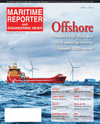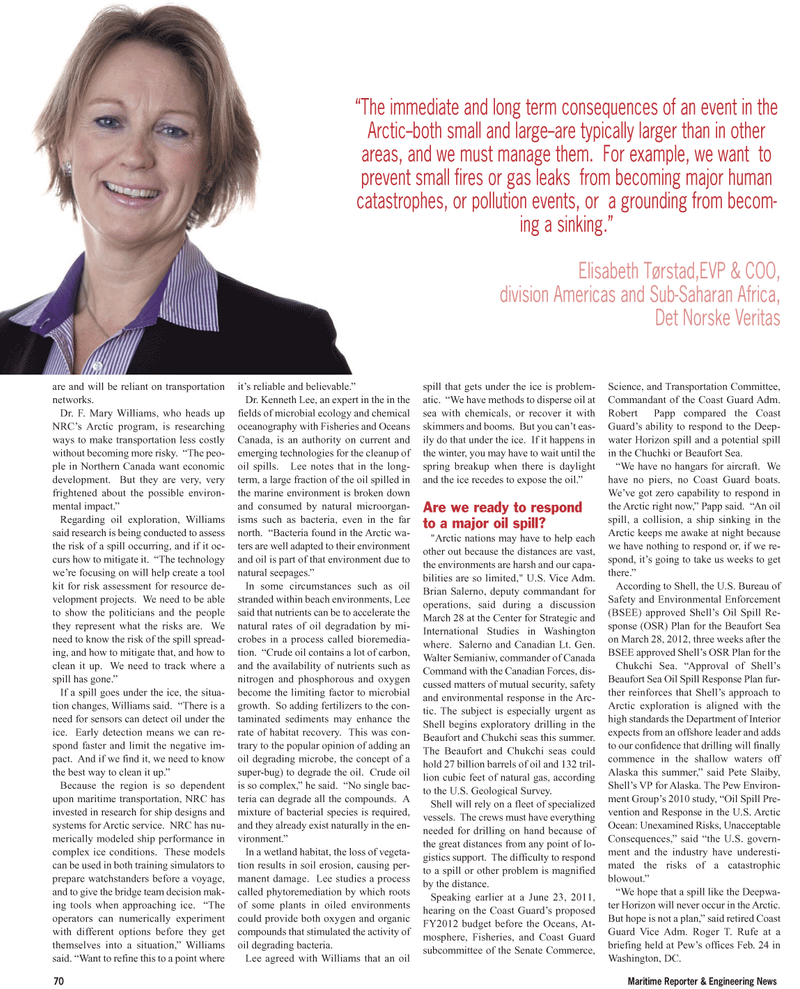
Page 74: of Maritime Reporter Magazine (April 2012)
Offshore Deepwater Annual
Read this page in Pdf, Flash or Html5 edition of April 2012 Maritime Reporter Magazine
70Maritime Reporter & Engineering News are and will be reliant on transportationnetworks. Dr. F. Mary Williams, who heads up NRCs Arctic program, is researching ways to make transportation less costly without becoming more risky. The peo- ple in Northern Canada want economic development. But they are very, very frightened about the possible environ- mental impact.? Regarding oil exploration, Williams said research is being conducted to assessthe risk of a spill occurring, and if it oc-curs how to mitigate it. The technology were focusing on will help create a tool kit for risk assessment for resource de-velopment projects. We need to be able to show the politicians and the people they represent what the risks are. We need to know the risk of the spill spread- ing, and how to mitigate that, and how to clean it up. We need to track where a spill has gone.? If a spill goes under the ice, the situa-tion changes, Williams said. There is a need for sensors can detect oil under theice. Early detection means we can re- spond faster and limit the negative im- pact. And if we find it, we need to know the best way to clean it up.? Because the region is so dependent upon maritime transportation, NRC hasinvested in research for ship designs and systems for Arctic service. NRC has nu- merically modeled ship performance incomplex ice conditions. These models can be used in both training simulators toprepare watchstanders before a voyage, and to give the bridge team decision mak- ing tools when approaching ice. The operators can numerically experiment with different options before they get themselves into a situation,? Williams said. Want to refine this to a point where its reliable and believable.? Dr. Kenneth Lee, an expert in the in the fields of microbial ecology and chemical oceanography with Fisheries and Oceans Canada, is an authority on current andemerging technologies for the cleanup of oil spills. Lee notes that in the long- term, a large fraction of the oil spilled in the marine environment is broken down and consumed by natural microorgan- isms such as bacteria, even in the far north. Bacteria found in the Arctic wa- ters are well adapted to their environment and oil is part of that environment due to natural seepages.? In some circumstances such as oilstranded within beach environments, Lee said that nutrients can be to accelerate thenatural rates of oil degradation by mi- crobes in a process called bioremedia-tion. Crude oil contains a lot of carbon, and the availability of nutrients such as nitrogen and phosphorous and oxygenbecome the limiting factor to microbial growth. So adding fertilizers to the con- taminated sediments may enhance therate of habitat recovery. This was con- trary to the popular opinion of adding anoil degrading microbe, the concept of a super-bug) to degrade the oil. Crude oil is so complex,? he said. No single bac- teria can degrade all the compounds. A mixture of bacterial species is required,and they already exist naturally in the en- vironment.? In a wetland habitat, the loss of vegeta- tion results in soil erosion, causing per- manent damage. Lee studies a process called phytoremediation by which roots of some plants in oiled environments could provide both oxygen and organic compounds that stimulated the activity of oil degrading bacteria. Lee agreed with Williams that an oil spill that gets under the ice is problem-atic. We have methods to disperse oil at sea with chemicals, or recover it with skimmers and booms. But you cant eas- ily do that under the ice. If it happens inthe winter, you may have to wait until the spring breakup when there is daylightand the ice recedes to expose the oil.? Are we ready to respond to a major oil spill?"Arctic nations may have to help each other out because the distances are vast, the environments are harsh and our capa- bilities are so limited," U.S. Vice Adm. Brian Salerno, deputy commandant foroperations, said during a discussionMarch 28 at the Center for Strategic and International Studies in Washington where. Salerno and Canadian Lt. Gen. Walter Semianiw, commander of Canada Command with the Canadian Forces, dis- cussed matters of mutual security, safety and environmental response in the Arc- tic. The subject is especially urgent as Shell begins exploratory drilling in the Beaufort and Chukchi seas this summer. The Beaufort and Chukchi seas couldhold 27 billion barrels of oil and 132 tril-lion cubic feet of natural gas, according to the U.S. Geological Survey. Shell will rely on a fleet of specializedvessels. The crews must have everything needed for drilling on hand because ofthe great distances from any point of lo- gistics support. The difficulty to respond to a spill or other problem is magnified by the distance.Speaking earlier at a June 23, 2011,hearing on the Coast Guards proposed FY2012 budget before the Oceans, At- mosphere, Fisheries, and Coast Guardsubcommittee of the Senate Commerce,Science, and Transportation Committee, Commandant of the Coast Guard Adm. Robert Papp compared the Coast Guards ability to respond to the Deep- water Horizon spill and a potential spill in the Chuchki or Beaufort Sea. We have no hangars for aircraft. We have no piers, no Coast Guard boats. Weve got zero capability to respond in the Arctic right now,? Papp said. An oil spill, a collision, a ship sinking in theArctic keeps me awake at night because we have nothing to respond or, if we re- spond, its going to take us weeks to get there.? According to Shell, the U.S. Bureau ofSafety and Environmental Enforcement (BSEE) approved Shells Oil Spill Re- sponse (OSR) Plan for the Beaufort Seaon March 28, 2012, three weeks after the BSEE approved Shells OSR Plan for the Chukchi Sea. Approval of Shells Beaufort Sea Oil Spill Response Plan fur- ther reinforces that Shells approach to Arctic exploration is aligned with the high standards the Department of Interiorexpects from an offshore leader and adds to our confidence that drilling will finally commence in the shallow waters off Alaska this summer,? said Pete Slaiby, Shells VP for Alaska. The Pew Environ- ment Groups 2010 study, Oil Spill Pre- vention and Response in the U.S. Arctic Ocean: Unexamined Risks, Unacceptable Consequences,? said the U.S. govern- ment and the industry have underesti- mated the risks of a catastrophicblowout.? We hope that a spill like the Deepwa- ter Horizon will never occur in the Arctic. But hope is not a plan,? said retired Coast Guard Vice Adm. Roger T. Rufe at a briefing held at Pews offices Feb. 24 in Washington, DC. The immediate and long term consequences of an event in theArctic--both small and large--are typically larger than in other areas, and we must manage them. For example, we want to prevent small fires or gas leaks from becoming major human catastrophes, or pollution events, or a grounding from becom- ing a sinking.? Elisabeth Tørstad,EVP & COO,division Americas and Sub-Saharan Africa, Det Norske Veritas

 73
73

 75
75
